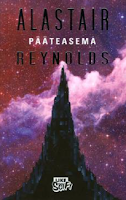Terminal World is one of Alastair Reynolds's standalone novels. Its Finnish title, Pääteasema, discarded the world part and is instead the (compound) word for terminal station. It gives off a somewhat different meaning but I suppose it can be interpreted in a more figurative way that aligns with the original too. But I definitely took it in the former and I think that threw me off a bit.
Reading the novel's Wikipedia article now, it appears there were several hints that the book's world is in fact no other than good old Mars -- just terraformed. Reynolds has evidently confirmed that himself. Mars is disappointingly mundane compared to the exciting, distant planet lightyears away I imagined it to be.The setting is a bit unusual nonetheless. There appears to have been some sort of apocalyptic event millennia ago. And it appears to be ongoing still, even if slowly. The only records of what happened are found in cryptic religious texts and fantastical stories. There are varying levels of technology but the majority of the novel is almost steampunk.
The story begins in Spearpoint where most of the civilization is centered. Spearpoint is a city on the sides of a massive spire, godscraper, that apparently goes high enough to reach space. Spearpoint and its surroundings are divided into invisible zones, each having a limit on what level of technology works: Neon Heights precinct's most advanced stuff will break when taken to Steamville and even steam engines are no good in Horsetown. Living beings crossing from one zone to another get hit by a dizzying sickness that needs to be treated with a drug. A comparison to Vernor Vinge's Zones of Thought pair of books is unavoidable, although Reynolds has not listed that in his sources of inspiration to World.
One character in the book has a theory about the zones or at least their nature. He has no idea how they came to be, though. I found the unsolved mystery quite frustrating when I had just finished the book. But now, knowing that the planet is Mars, I'm guessing that it was the terraforming technology that caused it. To my understanding, Mars's gravity is too weak to hold on to a life-supporting atmosphere. The ancient tech was probably able to do that artificially before it started slowly failing. I find it easy to believe that something on that level could cause fuckery to local laws of physics.
The novel starts with a pretty stylish, rather noir intro sequence where the viewpoint passes through two characters, as if the camera in a movie was following them each close up in turn, until ending up on the actual protagonist.
Quillon is not human -- as is immediately revealed -- but an angel, a posthuman species that lives on Celestial levels high up near Spearpoint's peak. They have access to the most advanced technology but, as Quillon later reveals, are not in the know of their planet's past any more than anyone else.
Angels are not normally able to survive in zones outside their own but Quillon has been altered as part of an experiment. The modification also included altering his appearance to pass as a human but it requires regular treatment as his wings keep growing back among other less obvious differences.
Quillon was originally part of an infiltration team of four. His partner was killed by the group's other two angels and Quillon killed them in turn. Since then, he's been working as a pathologist in Neon Heights, waiting for the consequences of his action to reach him -- which have just done so. During his stay, Quillon has become acquaintances with Fray, a resourceful human who is aware of Quillon's secret. Fray summons Meroka, an expert on smuggling people, to help Quillon flee to the Outzone, away from Spearpoint. I pictured Meroka as Glory from Shadowrun: Dragonfall for some odd reason. Maybe it was her personality.
There's not all that much futuristic sci-fi in Terminal World, which was a letdown for me. Like I mentioned, it's almost a steampunk adventure, with some mystical elements thrown in the mix. What made the novel still an entertaining read for me, was Quillon's profession and how other characters reacted to it. He's like Jonathan Reid in Vampyr: merely introducing yourself as a doctor is enough to make a good impression on complete strangers. Even if they don't trust you outright, the sheer practicality of having a medical practitioner around prevents them from dismissing you.


No comments:
Post a Comment